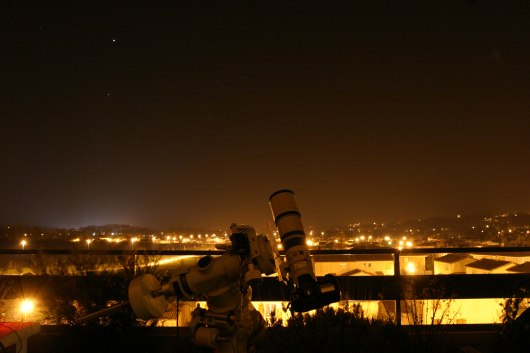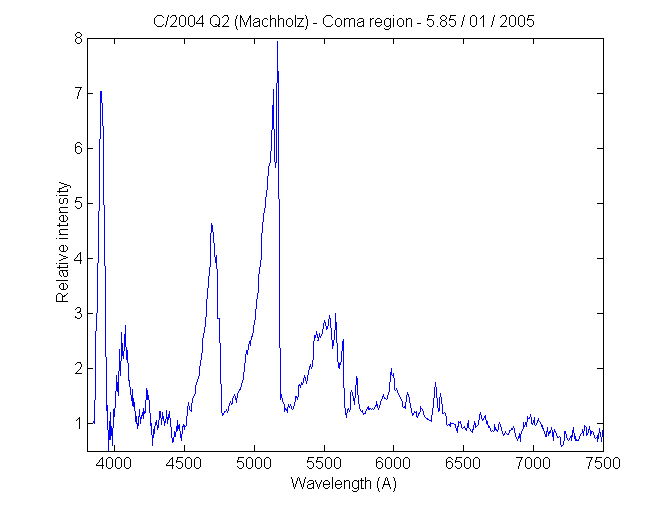
C/2004
Q2 (Machholz)

The observatory: A highly polluted residential area (not very favorable for faint cometary observations!). The equipment used for wide-field images is a Canon 400 mm f/5.6 L telephoto lens (click here for a test of this lens) and a Canon EOS 20D @ 400 ISO (RAW mode).
Observation
of January 15th 2005

Comet C/2004 Q2 the 15 January, 2005. Stack of 120 x 120 seconds exposures. Mid-exposure: 20:30 UT. The plasma tail is faint and diffuse.
Observation
of January 11th 2005
Comet Machholz near NGC
1333

Comet C/2004 Q2 near NGC 1333 (the nebulae is the faint glow near the center). The image is the sum of 8 x 120 seconds exposures.

Detail of the NGC 1333 area at the original scale of the EOS 20D + 400 mm f/5.6 lens images. Note the reddish of the stars. Stack of 122 x 120 seconds exposures.

Comet image taken on January 11 2004 - mid-exposure at 21:55 UT. 20 frames exposed each 120 seconds are summed. DDP processing under Iris.

Inner structure at 21:55 UT (rotational gradient processing).








Times series between 18:16 UT
and 22:12 UT (15 x 120 seconds exposure for each frame). The sequence shows
rapide change of the plasma tail. Click
here for
download an animated version (450 Kb).
Observation
of January 10th 2005

This picture is a stack of 119
x 2 minutes exposure. Mid-exposure: Jan.
10, 2005 - 20:05 UT..





Inverted b&w
version (sum of the G and B channel of the original RGB images) shown temporal
evolution of the plasma tail. Each images is the co-addition of 23 x 120 seconds
frame. From up to down the mid-exposure hour is 18:38 UT, 19:21 UT, 20:05 U,
21:04 UT, 21H55 UT.
Observation
of January 7th 2005
Comet Machholz near the
Pleiades (M45)

This picture is composed of two
assembled images. Stack of three 120 seconds exposure for each images. Jan.
7, 2005 - 18:00 UT. Click
here for download an enlarged version.



From
top to down, the aspect of the comet plasma tail at 18:00 UT (10 x 120 sec.
exposure), at 19:35 UT (20 x 120 sec. exposure) and at 22:45 UT (25 x 120 sec
exposure). Note the tail disruption displacement. At 22:45 UT the plasma tail
is very weak.

Negative
view of the thin plasma tail at 10:35 UT. Only the bleue and the green
channels of the RGB image are conserved for the better signal to noise
ratio..


Left,
logarithm view of coma + isophote curves. Right, a rotational gradient exhibit
some jets (Iris software processing).
Observation
of January 5.85 UT 2005
|
|
Observatory: Castanet Tolosan (France)
- IAU959 The left picture present the equipment used (note the suburban conditions). |

This
picture shown the 2-D spectrum of comet 2002 Q2 before removing the intense
sky lines (uniform vertical features). The comet's spectrum is the horizontal
line. The image is artificially and cover a spectral range from 380 nanometers
to 750 nanometers..Three spectral fields are necessary for cover this
range. The exposure time is of 13 x 180 sec. for the bleue part, 15 x 180
sec. for the green part and 8 x 180 sec. for the red part. The slit is
oriented east-west. Spectrum recorded on 5.85 UT Jan. 2005.

The sky-subtractecd 2-D spectrum of comet 2002 Q2.

The
final spectrum. The instrumental spectral response is corrected. So the
picture shown the true spectral distribution of comet 2002 Q2 Machholz. Notice
the intense line of CN at extreme left (wavelength of 388 nanometers).

False
color representation of the 2-D spectrum. Faint extension of the coma are more
visibles.

The
1-D spectrum of the coma region (co-addition of two area symmetrical relative
to the nucleus). The spectral sampling is of 5.75 A/pixel.

The
1-D spectrum of the nucleus region.

The
1-D spectrum of the nucleus region after removing the signal of a typical G2V
star (solr-like star). The contribution of dust is removed by the operation
and only spectral signature of gazes is conserved. For spectral identification,
see the Dec.12th 2004 observation.
Observation
of 12.91 UT 2004
Observatory: Castanet Tolosan (France)
- IAU959
Observer: Christian Buil
Instrument: Takahashi
FS-128 refractor (5-inch aperture) - MERIS
spectrograph (bin. 2x2 - sampling of 5.75 A/pixel) + Audine KAF-0401E CCD
camera
The final complete spectrum is a merge of three run: one for the bleu part (11 x 180 sec. exposure time), one for the green part (14 x 180 sec. exposure time), one for the infrared part (9 x 180 sec. exposure time).


Note 1: The intensity of 3880 angstroms
CN band is probably underestimated because the severe defocus of the dioptric
optic used in MERIS spectrograph (standard photographic lens) - see below.
Note
2: The spectra are corrected for the spectral response of the system.
Note 3: The feature near 5685 angstroms
is an artifact (NaI pollution lines removal procedure - the data are acquired
in suburban
condition).
Some aspects of the image processing

An
individual 180 seconds raw exposure. The Machholz spectrum is the fine horizontal
line near the center.
Note the presence of "hot pixels", the presence
of a severe light pollution (High Pressure Sodium lamps), and the presence of
irregularity along the slit ("transversalium" effect, i.e. the horizontal
dark features).

The
result of stack of 14 x 180 sec. images, the correction of optical distortion
(smile and tilt effects) and the correction of transversalium effect. The image
is artificially colored.
![]()
The
final 2D spectrum (sky pollution lines are removed). IRIS
software processing.
The intense [0I] emission is clearly visible (see in
the red part of the spectrum).
![]()
The
bleue region in the 2D spectrum. The CN band at 3880 A is visible at the
extreme left.
![]() µ
µ
The
infrared region.


C/2004
Q2 through the enlarged entrance slit of the spectrograph (zero order image).
Left, linear false color view, right, logarithmic view + ramp effect.
See also C/2001 Q4 (NEAT) observation.